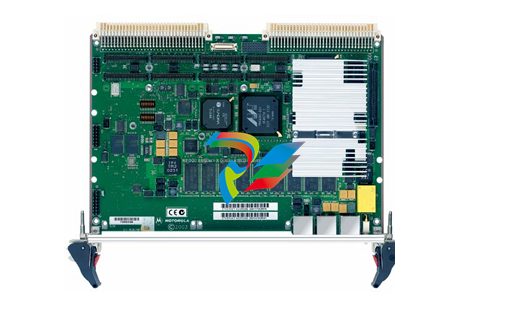
MVME6100 Series VMEbus Single-Board Computer
The MVME6100 is the first
VMEbus SBC designed with
the Tundra Tsi148 VMEbus
interface chip
2eSST VMEbus protocol with
320MB/s transfer rate across
the VMEbus
® processor
MPC7457 PowerPC
running at up to 1.267 GHz
128-bit AltiVec coprocessor for
parallel processing, ideal for
data-intensive applications
Up to 2GB of on-board DDR
ECC memory and 128MB of
lash memory for demanding
applications
Two 33/66/100 MHz PMC-X
sites allow the addition of
industry-standard, application
specific modules
Dual Gigabit Ethernet interfaces
for high performance networking

The MVME6100 series from Emerson Network Power is the first VMEbus single
board computer (SBC) designed with the Tundra Tsi148 VMEbus interface chip offering
two edge source synchronous transfer (2eSST) VMEbus performance. The 2eSST
protocol enables the VMEbus to run at a practical bandwidth of 320MB/s in most
cases. The MVME6100 is designed to meet the needs of OEMs servicing the defense
and aerospace, industrial automation and medical imaging market segments.
The MVME6100 series provides more than just faster VMEbus transfer rates; it
provides balanced performance from the processor, memory subsystem, local
buses and I/O subsystems. Customers looking for a technology refresh for their
application, while maintaining backwards compatibility with their existing VMEbus
infrastructure, can upgrade to the MVME6100 series and take advantage of its
enhanced performance features.
The promise of the VME Renaissance is innovation, performance and investment
protection. The MVME6100 series from Emerson delivers on this promise. The
innovative design of the MVME6100 provides a high performance platform that
allows customers to leverage their investment in their VME infrastructure.
The MVME6100 series supports booting a variety of operating systems including
a complete range of real-time operating systems and kernels. A VxWorks board
support package and Linux support are available for the MVME6100 series.
Overview
VMEBuS 2ESST PErforManCE
The 2eSST protocol has existed for some time (the draft
standard for trial use was published in 1999 and released
as an ANSI standard in 2003), but until now, 2eSST
boards would not work in a standard VMEbus backplane
because the existing VMEbus transceivers could not
support the required VMEbus 2eSST signaling speeds.
Texas Instruments developed new VMEbus transceiv
ers that support the VMEbus signal switching speeds
required by the 2eSST protocol. The combination of
the new Texas Instruments VMEbus transceivers and
the Tsi148 VMEbus legacy protocol support allows
customers to integrate the MVME6100 series into their
existing infrastructure providing backward compatibility
and thereby preserving their investment in existing
VMEbus boards, backplanes, chassis and software.
BalanCEd PErforManCE
The MVME6100 series provides more than just faster
VMEbus transfer rates; it provides balanced performance
from the processor, memory subsystem, local buses
and I/O subsystems. The processor, running at speeds
of 1.267 GHz, is ideal for data-intensive applications.
The state-of-the-art host bridge, with support for a
133 MHz host bus and a 133 MHz DDR memory bus, is
well matched to the processor. To ensure that the
MVME6100 series can handle the 320MB/s data rates
of 2eSST, the Tsi148 VMEbus interface chip is connected
to one of the 133 MHz PCI-X buses on the host bridge.
The second PCI-X bus has dual PMC-X sites—each site
supports PMC or PMC-X cards supporting PCI bus
speeds from 33 to 100 MHz. The MVME6100 also
offers dual Gigabit Ethernet interfaces. All of this adds
up to a set of well-balanced, high-performance
subsystems for unparalleled performance.

Application Benefits
dEfEnSE and aEroSPaCE
In the defense and aerospace market segment, the
MVME6100 series is well suited for command and
control applications that utilize commercial grade
products such as naval sheltered systems, stationary
ground systems, and reconnaissance aircraft systems.
The MVME6100 series helps to provide more performance
for these applications than previous VME solutions
have been able to supply by using the 1.267 GHz
processor. This combined with dual PCI-X buses
capable of 100 MHz speed for PMC modules and an 8x
increase in the VME bandwidth eliminates many of the
bottlenecks faced by command and control solutions
today. These applications can now take advantage of
the latest PowerPC processors in a dense computing
configuration without the difficulties of trying to cool
multiprocessor boards and managing I/O and VME
bottlenecks. With the addition of Emerson’s processor
PMCs (PrPMCs), additional PowerPC architecture
compatible processors can be added for a multiprocessor
solution without sacrificing any of the MVME6100
series benefits.
InduSTrIal auToMaTIon
The MVME6100 is also ideally suited for semiconductor
process equipment (SPE), automated test equipment
(ATE) and a variety of other high-end industrial
automation applications because of its increased bus
bandwidth and faster processing speeds. The backwards
compatibility of the MVME6100 series with existing
VME products helps to provide OEMs a way to extend
the life and capability of their current designs without
sacrificing existing key hardware and software




























































































































